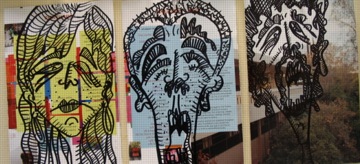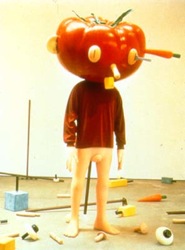
On the topic of art and controversy, I thought I’d share a teaching-related story of my own. Previously to working at Art21, I was an associate educator at the New Museum, where I ran a high school program called G:Class. While the museum was closed during construction of its new building, I relied on Chelsea galleries to explore curricular connections to contemporary art. As a way to help develop a sense of network and inter-connectivity among students in different classes across the city, I developed a mail art project on the heels of Frank Warren’s Post Secret, connecting it to a Ray Johnson exhibition and the documentary about his work, How to Draw a Bunny. I asked each student to create a postcard-sized artwork to be sent to another student through the mail. Students had to investigate something they feared, something they loved, or if they were really ambitious, both. They also had to consider that this work would travel through the United States Postal Service and the student who received it would respond with another piece of mail art.
A week after I assigned the project, we met at Feigen Contemporary gallery to present the finished project and begin our tour. It was a small group of 12 students and the discussion was dynamic, involving talking about process and the ideas that inspired their creations. One student sheepishly presented two postcards. One of his postcards featured a detailed graphite rendering of an erect penis and, on the other side, a vagina. The second postcard featured a red background with stick figures in different sexual positions with a white substance smeared on the other side (it was Elmer’s glue.)
I could feel my face burning and imagined that it must be beet red. Here I was, exposed in front of these students. How was I going to deal with it? I saw the student shrink because of my reaction, so I took a deep breath and knew that if I didn’t acknowledge my own emotional reaction I would not be able to deal with this situation responsibly. I told the class I was a bit shocked and embarrassed and in admitting that, I was able to regain my composure.
I asked the student what he was trying to communicate. He told me he questioned why certain behaviors and images are deemed “appropriate,” while others were “inappropriate.” Why are certain things considered pornographic, but billboards in Times Square or primetime television shows are not? Why are some things considered private while others are public? These comments intrigued me and were justifiable concerns. We had a productive conversation about these issues as a group, while acknowledging how his artwork failed to communicate this nuanced idea and just shocked us. It was one of those difficult moments in teaching where a boundary was definitely crossed but presented a rare and important learning opportunity for both the student and myself.
I returned to the school and next week armed with reproductions of certain artworks that explored elements of sex, sexuality, and issues of privacy. These examples included work by Paul McCarthy, Wangechi Mutu, Marina Abramovic, and Keith Haring. We talked about these artists’ works, the ways in which sex and sexuality are part of daily culture, and how artists use different strategies to question ideas of the public and private, sex, and sexual identity. While this “lesson” would never be part of my regular class preparation, it provided a rare opportunity to address issues relevant to students in an open and respectful way.


Wangechi Mutu, Yo Mama (2003) and Paul McCarthy, Tomato Head (1994)
I’m curious how other educators have tackled similar scenarios. How has sex and sexuality come up in your classes? What were those situations and how did you deal with them? Please share your stories by leaving a comment below.




Pingback: Reflection in the Porcelain Pond | Art21 Blog